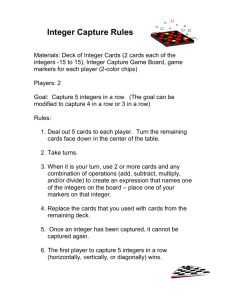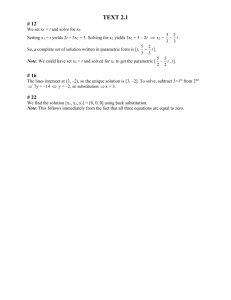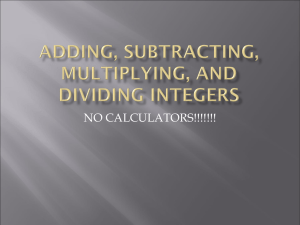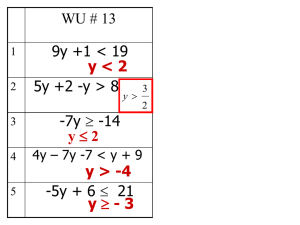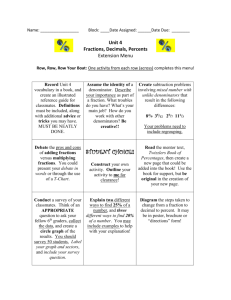Mathematical Surprises
advertisement
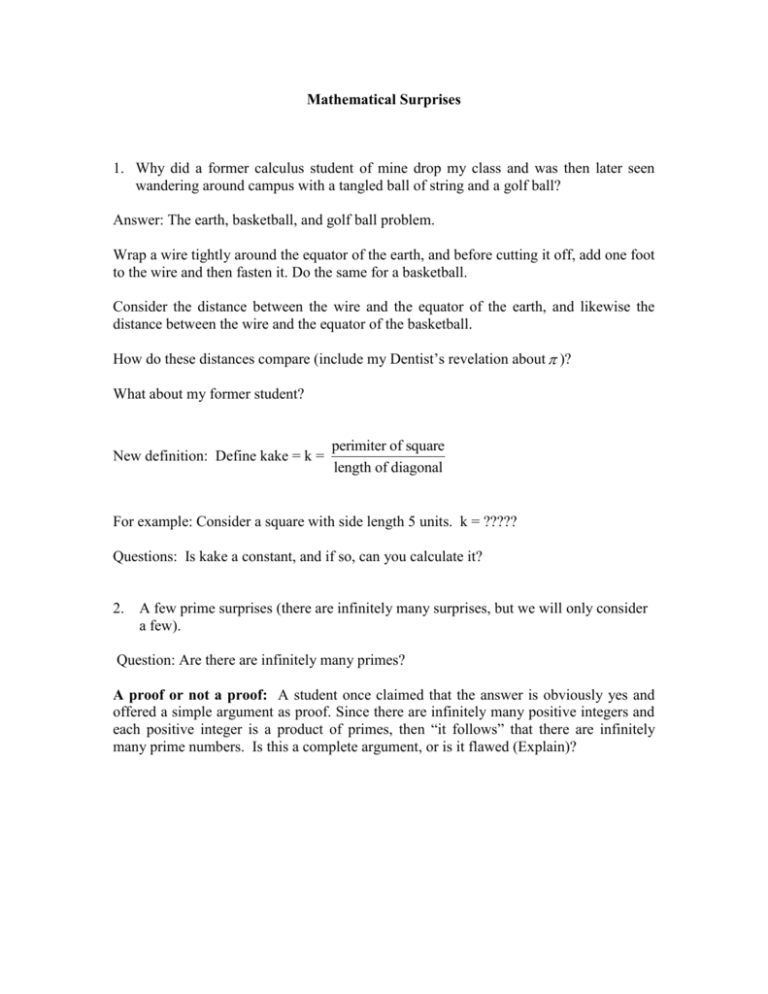
Mathematical Surprises 1. Why did a former calculus student of mine drop my class and was then later seen wandering around campus with a tangled ball of string and a golf ball? Answer: The earth, basketball, and golf ball problem. Wrap a wire tightly around the equator of the earth, and before cutting it off, add one foot to the wire and then fasten it. Do the same for a basketball. Consider the distance between the wire and the equator of the earth, and likewise the distance between the wire and the equator of the basketball. How do these distances compare (include my Dentist’s revelation about )? What about my former student? New definition: Define kake = k = perimiter of square length of diagonal For example: Consider a square with side length 5 units. k = ????? Questions: Is kake a constant, and if so, can you calculate it? 2. A few prime surprises (there are infinitely many surprises, but we will only consider a few). Question: Are there are infinitely many primes? A proof or not a proof: A student once claimed that the answer is obviously yes and offered a simple argument as proof. Since there are infinitely many positive integers and each positive integer is a product of primes, then “it follows” that there are infinitely many prime numbers. Is this a complete argument, or is it flawed (Explain)? At this time, we are not going to discuss a valid proof that there are infinitely many prime numbers, but will talk about a question that arises from Euclid’s proof of this fact. Namely, consider that numbers defined as follows: a n = multiplying first n primes and then adding 1. a1 2 1 2 1 3 a2 (2 3) 1 7 a3 (2 3 5) 1 31 a4 (2 3 5 7) 1 211 a5 (2 3 5 7 11) 1 2311 From this limited evidence, one might be tempted to say????????? Note that a6 (2 3 5 7 1113) 1 59 505 Open Questions: (i). Does the sequence a1 , a2 , a3 ,... contain infinitely many prime numbers? (ii). Does the sequence a1 , a2 , a3 ,... contain infinitely many composite numbers? Another question concerning primes and composites: How many consecutive composite numbers can you find? For example, here are 5 consecutive composites: 24,25,26,27,28. Can you find 6, 7, 8, etc. consecutive composite numbers? A clever use of “factorial” makes it quite easy to produce n consecutive composites for any integer n ≥ 1. For example, if n = 3, the following list consists of three consecutive composites: 4! + 2 = 26, 4! + 3 = 27, 4! + 4 = 28. Clearly these are not the smallest three consecutive composites, but nevertheless they are three consecutive composites. For another example, say n = 6 consecutive composites, consider the list 7! + 2, 7! + 3, 7! + 4, 7! +5, 7! + 6, 7! + 7, and for n ≥ 1 consecutive composites, the following general list works as well: (n + 1)! + 2, (n + 1)! + 3, (n + 1)! + 3,…, (n + 1)! + n, (n + 1)! + (n + 1). 3. Question: How many points in the plane can be found with the property that the distance between any two of them is always an integer (not necessarily the same integer)? Easy answer: Infinitely many; for example, any collection of integer points on the xaxis has this property. More generally, it is geometrically obvious that any line contains infinitely many points that are integer distances apart (simply lay out integer distances on any line). Modified question: How many non-collinear points in the plane can be found which have the property that the distance between any two of them is an integer? Exercise: Find a set that contains 8 points that are integer distances apart. Question: Is it possible to find for any integer n ≥ 3, a set of n points in the plane such that no three are collinear and the distance between any two is an integer? Although it is not entirely obvious how to produce such sets of points, it does turn out that they exist. In fact, a bit of trigonometry and some theory of complex numbers can be used to produce an example. Question: Is it possible to find an infinite collection of non-collinear points in the plane such that the distance between any two of them is an integer? The surprising answer is NO, and a Theorem of Anning and Erdös deals with this explicitly. Their proof was a bit messy, and Irving Kaplansky asked Erdös (1913-1996) if he could find a simpler proof. What Erdös discovered was not only elementary but amazingly elegant. 4. Checker Jumping: How high can you jump? Consider an infinite checkerboard with as many pieces below the fold as you choose. The only moves that are allowed in this game are horizontal and vertical jumps. As in usual checkers, the piece that is jumped is removed from the board. The object of the game is to move a piece to the highest row possible above the fold with the least number of starting pieces below the fold. Row 1: 2 pieces are needed to get to row 1 above the fold. Fold Row 2: 4 pieces are needed to get to row 2 above the fold. Row 3: 8 pieces are needed to get to row 3 above the fold. Row 4: What is the least number of pieces needed to get to row 4? Answer: You might think that 2 4 16 pieces could reach row 4, but the least number is 20 pieces. Challenge: Get to row 4. Question: What is the least number of pieces needed to reach row 5? Answer: It is impossible to reach row 5 (or above)!!!!!! We will show that it is impossible to reach an arbitrary position P in row 5. x6 x5 x4 x5 x6 x7 x8 x9 x10 x5 x4 x3 x4 x5 x6 x7 x8 x9 x10 x4 x3 x2 x3 x4 x5 x6 x7 x8 x9 x3 x2 x x2 x3 x4 x5 x6 x7 x8 x2 x P x x2 x3 x4 x5 x6 x7 x3 x2 x x2 x3 x4 x5 x6 x7 x8 x4 x3 x2 x3 x4 x5 x6 x7 x8 x9 x5 x4 x3 x4 x5 x6 x7 x8 x9 x10 x6 x5 x4 x5 x6 x7 x8 x9 x10 5 4 3 2 1 Fold Weight each checker square with a value x n , where n is the number of unit steps in directions parallel to the axes in a shortest path from the point P. The value of the box that P occupies is x 0 1 . The value of any collection of pieces is taken to be the sum of the values of the boxes occupied by the pieces. The change in value of a set of pieces: 3 possibilities 1. moving closer to P 2. moving farther from P 3. moving the same distance from P a). Change representing a move of type 1: x n (x n1 x n 2 ) x n (1 x x 2 ). Choose x so that there is no change in value for a move of type 1, i.e., x n (1 x x 2 ) 0 1 x x 2 0. Thus, x 1 5 , and we will choose x to be the positive root 2 Note that 0 5 1 1. 2 5 1 . 2 Remark: x is the reciprocal of the golden mean 1 5 . 2 Note that since 1 x x 2 0 , then 1 x x 2 . b). Change representing a move of type 2: x n2 (x n1 x n ) x n (x 2 x 1). Using the value of x chosen, we have x n (x 2 x 1) x n (1 x x 1) x n (2x) 0. and thus a move of type 2 results in a decrease to the value of a collection of pieces. c). Change representing a move of type 3: x n (x n1 x n ) x n1 < 0. Summary: Every jump either leaves the value of a set of pieces unchanged or it makes it less; under no circumstances does the value increase. A piece at point P would have itself value 1. Thus a set of pieces sending a piece to the point P would have to begin with a value at least 1. We’ll determine the value of a collection of pieces occupying all positions below the fold. Column directly below P and below the fold has the value: x5 , since 0 < x < 1. The two columns, one on 1 x each side of this central one, add as follows: x 5 x 6 x 7 ... x 5 (1 x x 2 ...) 2(x 6 x 7 x 8 ...) 2x 6 (1 x x 2 ...) 2x 6 . 1 x 2x 7 Similarly, there are two columns x x x ... for a total of . 1 x 7 8 9 The total of the values of all pieces below the fold equals S x6 x5 x7 x8 2 ... 1 x 1 x 1 x 1 x x5 2x 6 (1 x x 2 ...) 1 x 1 x 2x 6 x5 2x 6 1 x5 1 x 1 x 1 x 1 x (1 x)2 x 3 2x 2 x(x 2 2x) x(1 x 2x) x(1 x) x x 2 x 1 x 1. Thus even a single unoccupied place in the starting zone means that the starting value of the set has a value < 1, and this is too small to send a piece to row 5.
